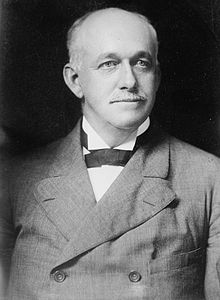Henry E. Huntington
| Henry E. Huntington | |
|---|---|
 |
|
| Born |
Henry Edwards Huntington February 27, 1850 Oneonta, New York |
| Died | May 23, 1927 (aged 77) Philadelphia |
| Residence |
Huntington Library San Marino, California |
| Spouse(s) |
Mary Alice Prentice Arabella Huntington |
Mary Alice Prentice
Henry Edwards Huntington (February 27, 1850 – May 23, 1927) was an American railroad magnate and collector of art and rare books. Huntington settled in Los Angeles, where he owned the Pacific Electric Railway as well as substantial real estate interests. In addition to being a businessman and art collector, Huntington was a major booster for Los Angeles in the late 19th and early 20th centuries.
Born in Oneonta, New York, Henry E. Huntington was the nephew of Collis P. Huntington, one of The Big Four, the men instrumental in creating the Central Pacific Railroad (later called Southern Pacific), one of the two railroads that built the transcontinental railway in 1869. Huntington held several executive positions working alongside his uncle with the Southern Pacific. After Collis P. Huntington's death, Henry E. Huntington assumed Collis Huntington's leadership role with Newport News Shipbuilding and Drydock Company in Virginia, and married his widow Arabella Huntington. His divorce from his first wife, Mary Alice Prentice, birth sister of his Uncle Collis' adopted daughter, in 1910 and marriage to Arabella in 1913 after Mary Alice's death shocked San Francisco society. He had four children with Mary Alice: Howard Edward, Clara Leonora, Elizabeth Vincent, and Marian Prentice, but none with Arabella. Arabella's son Archer, from her prior marriage from which she was widowed, had earlier been adopted by Collis.
In 1898, in friendly competition with his uncle's Southern Pacific, Huntington bought the narrow gauge, city oriented Los Angeles Railway (LARy) known colloquially as the 'Yellow Car' system. In 1901, Huntington formed the sprawling interurban, standard gauge Pacific Electric Railway (the PE), known as the 'Red Car' system, centered at 6th and Main Streets in Los Angeles. Huntington succeeded in this competition by providing passenger friendly streetcars on 24/7 schedules, which the railroads couldn't match. This was facilitated by the boom in Southern California land development where houses were built in places such as Orange County's Huntington Beach, a Huntington-sponsored development, where streetcars served passenger needs that the railroads had never considered. Connectivity to Downtown Los Angeles made such suburbs feasible.
...
Wikipedia
